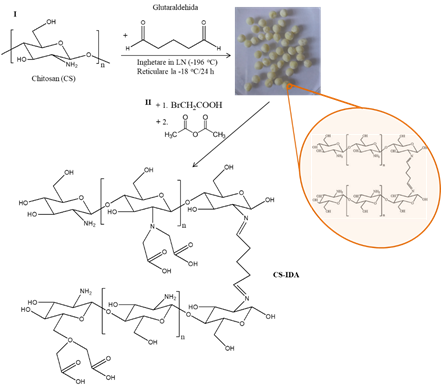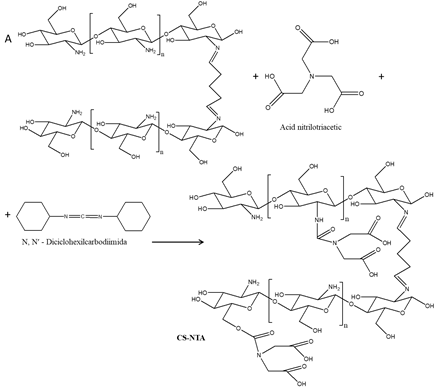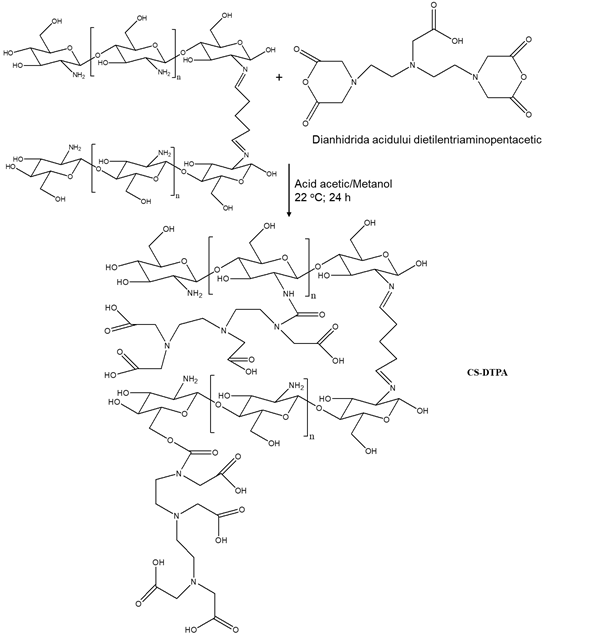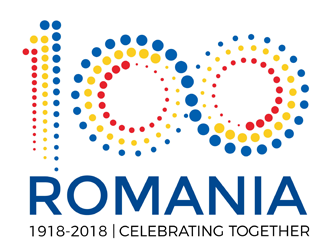|
Engineered eco-friendly biocomposites with selective chelating properties for removal and recovery of heavy metal ions from contaminated waters

|
| Home Team Members Project Abstract Objectives Budget Dissemination Contact |
Stage 2019: ![]()
Objective 1: Synthesis and characterization of ligand-functionalized polysaccharides.
Objective 2: Design of novel porous ligand-functionalized biocomposites embedding natural aluminosilicates.
Objective 4: Modeling and optimization of polysaccharide modification, composite preparation and heavy metal ion sorption using tools of artificial intelligence.
Objective 5: Training/specialization of PhD and MS students, as well as the dissemination of project results.
Stage 2/2019 – Activities
A2.1. Functionalization of polysaccharides with aminopolycarboxilic acid moieties by chemical modification of biopolymer functional groups;
A2.2. Synthesis of amidoxime-functionalized polysaccharides by grafting polyacrylonitrile on biopolymer backbone, followed by its modification with hydroxylamine;
A2.3. Characterization of ligand-functionalized polysaccharides;
A2.4. Preparation of porous composites by cryogelation;
A2.5. Structural and morphological characterization of porous composites;
A2.6. Evaluation of the mechanical properties of composites as a function of synthesis parameters;
A2.7. Preparing the modeling and optimization methodologies based on artificial neural networks,
genetic and differential evolution algorithms, respectively;
A2.8. Specialization and training of MS and PhD students;
A2.9. Update of scientific information on the project field, and formulation of working protocols and modeling methodologies;
A2.10. Preparation and submission of manuscripts to ISI ranked journals;
A2.11. Construction of the project web-page and its continuous update.
Stage 2/2019 – Results
- The functionalization of chitosan (CS)-based cryo-beads with iminodiacetic (IDA), nitrilotriacetic (NTA), and diethylene triamine pentaacetic ligand groups (DTPA) were performed according to the following schemes:
|
Scheme 1. Functionalization of CS-based cryo-beads with IDA |
|
Scheme 2. Functionalization of CS-based cryo-beads with NTA |
|
Scheme 3. Functionalization of CS-based cryo-beads with DTPA
• Attachment of aminopolycarboxilic acid ligand groups (IDA, NTA, and DTPA) onto CS chains was proved by 1H-RMN and FTIR spectroscopy.
- Porous biocomposites embedding natural aluminosilicates with distinct recognition sites and anisotropic morphology were obtained by a combination of ion-imprinting methodology and unidirectional freezing technique. A schematic representation of this strategy is presented in Figure 1.
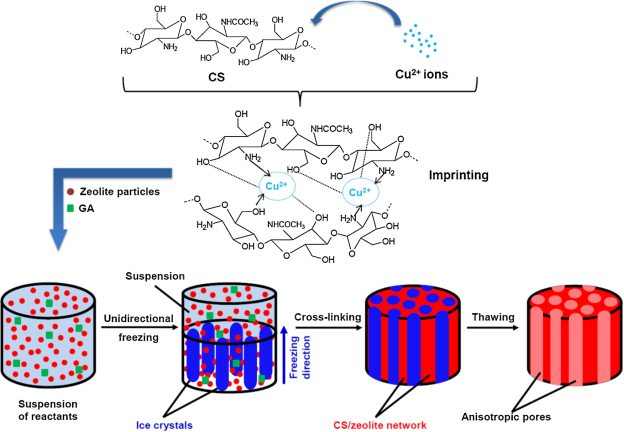
Figure 1. Preparation of ion-imprinted biocomposites with distinct recognition sites and anisotropic morphology, using a combination of ion-imprinting methodology and unidirectional freezing pathway.
-
Formation of 3D porous CS-based biocomposites was evaluated by several methods of characterization (FTIR spectroscopy, optical microscopy, SEM, BET, EDX, swelling behavior, mechanical properties, metal ion retention capacity, decolorization efficiency of some dyes).
-
The CS-based biocomposites exhibited a remarkable chemical stability during the loading/leaching steps of metal ions, the sorption capacity remaining almost constant after the 5th cycle. Additionally, the optical images of the biocomposite after loading with heavy metal ions (Figure 2A) and after desorption of heavy metal ions and regeneration (Figure 2B) show no change in the disc shape of the sorbent without any cracks or defects development. Moreover, the SEM micrographs taken for the biocomposite (Figures 2C and 2D) proved that the internal morphology of the biocomposite was not affected by the experimental conditions used for the heavy metal ions desorption and sorbent regeneration. The chemical composition on the surface of IIC sorbent determined from EDX measurements indicated that the value of Si/Al ratio was unaffected being almost 6 (Figure 2E). This result shows that the natural zeolite is stable within CS matrix and under all experimental conditions.
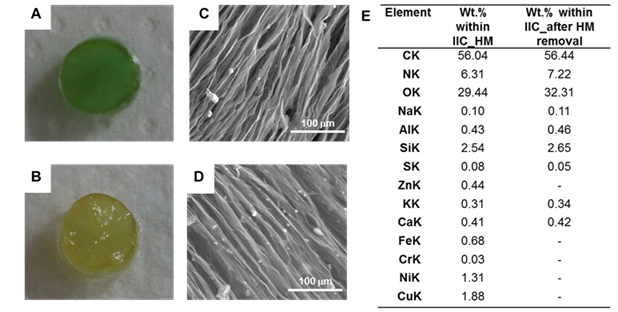
Figure 2. (A) Optical picture of biocomposite in swollen state after loading of heavy metal (HM) ions. (B) Optical picture of biocomposite in swollen state after desorption of HM ions with 0.1 N HCl and regeneration with 0.1 N NaOH. (C) SEM micrograph of biocomposite loaded with HM ions. (D) SEM micrograph of biocomposite after desorption of HM ions and regeneration. (E) The chemical composition on the surface of biocomposite determined from EDX measurements.
-
The MS student, Ancuta Dumitrita Tapalaga, performed a research stage at Universidad Complutense de Madrid, in the frame of TE117/208 project for a training on atomic absorption spectrometer equipment and for a study on removal efficiency of several metal ions from wastewaters using ligand-functionalized chitosan-based composites. The research stage was performed between 16th of June 2019, and 25th of June 2019.
-
Based on the results obtained in this stage, four manuscripts were prepared and submitted for publication, three of them being already accepted. Also, these results were presented at national and international scientific meetings (1 invited lecture, 7 oral communications, and 1 poster).
| Stage 2018 |
| Stage 2019 |
| Stage 2020 |
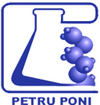
| Designed & Maintained by CLICK NET SOLUTIONS |
